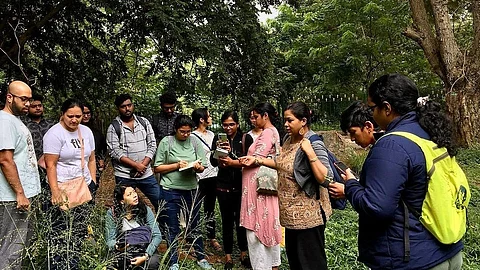

While living in Goa during the Covid-19 pandemic, Parveen Choudhury — now based in Bengaluru — took up regular, purposeful walks to pass the time. During these walks, she came to learn about various herbs, weeds and grasses used in cooking.
“The walks in Goa fascinated me and that’s how I began foraging for food in urban spaces,” Choudhury said. “Today, I live in Bengaluru surrounded by lakes and it’s quite common to find ingredients that can be gathered and used in cooking.”
As her interest in foraging grew, Choudhury began following Shruti Tharayil on social media. Through her Instagram handle Forgotten Greens, Tharayil documents wild and edible greens that grow in the overlooked corners of India’s urban areas.
Choudhury, who has joined Tharayil on wild food walks, noted that there are still areas in cities where residential development hasn’t taken over and where many plants, weeds and grasses continue to thrive.
“I identify them when I forage. At home, I even have uncultivated greens like clover growing naturally in my plant and flower pots,” she said.
She admitted that her foraging sometimes draws curious looks. “But many urban dwellers are becoming more aware of wild edible greens and find it interesting,” she said. “In Bengaluru’s Cubbon Park, people engage in a variety of activities, including foraging. Uncultivated greens are full of nutrients and should be part of our diets.”
Tharayil, who splits her time between Tamil Nadu and Kerala, conducts wild food walks across Indian cities with around 15 participants at a time. She is deeply interested in wild and forest foods, as well as the idea of urban foraging.
“After completing my post-graduation, I used to work with tribal communities. That’s when I first saw them eating items that I hadn’t grown up considering food. Back then, my understanding of food was limited to rice, pulses and a few vegetables sold in the market,” she recalled. “But while living with tribals, I saw them regularly foraging for leafy greens in forest areas.”
When she recounted this experience to her mother, she learnt that many non-tribal communities also used to forage. “That’s when I realised this wasn’t exclusive to tribal life. I gradually gathered more information and in 2018, I launched my Facebook page Forgotten Greens, as there wasn’t much content available online,” Tharayil said.
Today, Tharayil focuses on helping people identify what grows around them, emphasising the need to localise food systems. According to her, parks, tank bunds and lake bunds are the best places for foraging in cities.
“Women often forage in parks. Seasonal fruits are also collected. Though plucking from trees is sometimes prohibited, I still encourage people to explore wild foods. My focus is on the identification process,” she said.
In one post, Tharayil mentions discovering Malabar spinach in her maternal grandmother’s kitchen garden. Known as Poi Saag in eastern India, it is a regional delicacy. She also highlights the versatility of Asthma weed, which can be used in curries, added to lentils, or brewed into tea.
Bengaluru-based Isha Agarwal, who works for a multinational consulting firm, was introduced to wild foraging after meeting a woman in Auroville and later joining Tharayil on a walk.
“I love gardening, so wild foods and herbs fascinate me. Since my child is still young, I don’t go out as often to parks and empty plots. But whenever I do go for a walk and come across weeds or herbs, I collect them. I’ve even seen spinach growing in my housing society,” she said.
Originally from Rajasthan, Agarwal emphasised the importance of Bathua saag, a nutritious weed commonly available in winter and integral to Rajasthani cuisine. “People say many things are unavailable in cities, but they can be found if you look closely. I’ve cooked with foraged foods — like using New Zealand spinach in salads or oxalis leaves in dishes,” she said.
Beyond tribal communities, other marginalised groups also forage, which helps them access nutritious food gathered from forested areas. Prashant Mohanty, based in Bhubaneswar, runs Nirman, an organisation that works on biodiversity, wild foods and food foraging.
“Nirman was established in 1997 and for the past 15 years I’ve focused on the link between food and forests,” Mohanty said. “I work with various tribal communities who live close to forests and depend on them for sustenance. Other communities, who don’t have direct access, often buy wild greens sold along roadsides in Gajapati and Rayagada districts.”
According to Mohanty, items like mushrooms and seasonal fruits such as Kendu (Coromandel ebony) are prized for their nutritional value. He spoke of a particular mushroom in Rayagada that sells for Rs 700 per kilogramme in the market.
As wild foods and greens are harder to find in cities, Nirman promotes them through food festivals. Mohanty recalled the Adanga (Cycas nayagarhensis), a plant traditionally used in rituals, whose leaves were once sold by traders. “In my childhood, its leaves were used in pujas. Today it is nearly extinct and over the past two years, I’ve campaigned for its conservation in Nayagarh district. Its fruits are delicious — I tasted them at a food festival.”
He added that city parks are often filled with decorative plants. “But why not have fruit-bearing trees instead?”